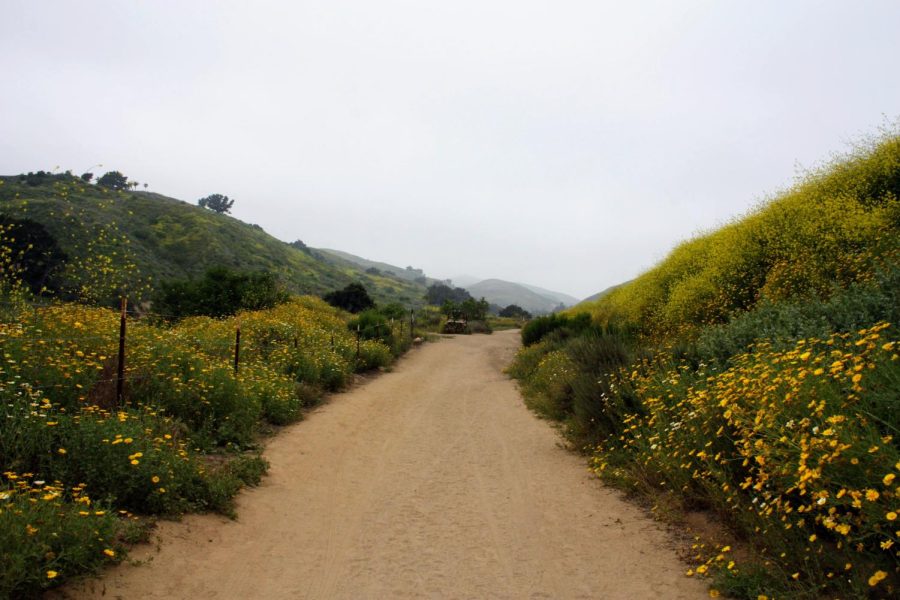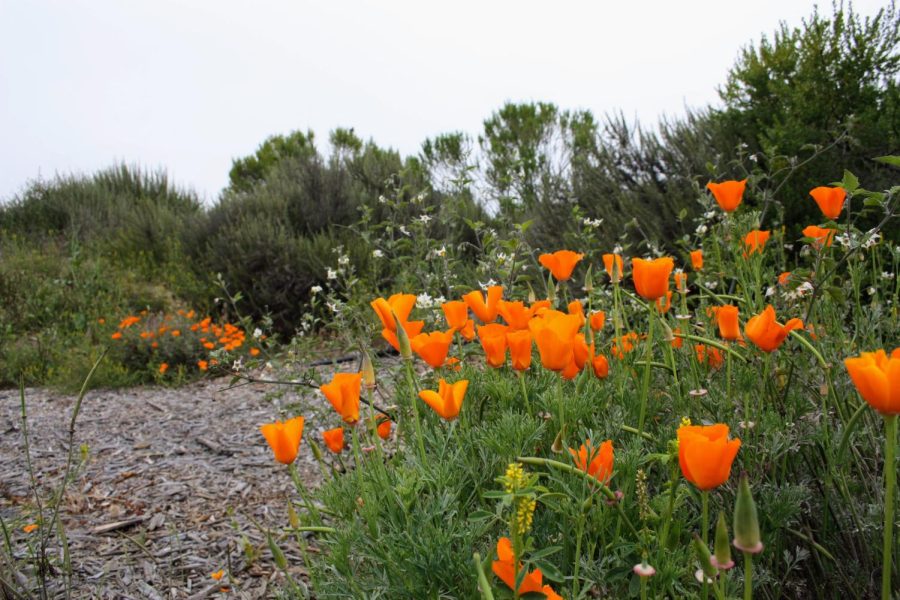Ventura’s superbloom: Yellow flowers or invasive weeds?
Invasive black mustard plants are abundant along the main trail at Harmon Canyon. They vastly outnumber native plants, which is detrimental to various aspects of the environment. Come fall, black mustard will dry out and pose a prominent fire hazard.
June 1, 2023
Has your Instagram feed been bombarded with photos of California’s superbloom recently? After a wet winter, spring has sprung and Ventura’s luscious, green hillsides are littered with patches of vibrant yellow flowers. One would assume that these “flowers” are harmless, but they’re actually an extremely invasive weed known as Brassica nigra, or black mustard. Thriving off of 2023’s record rainfall, this ultra-resilient plant has sprouted in almost every crevice in Ventura, from Harmon Canyon to empty roadsides.
Laura Pavliscak, Conservation Director of the Ventura Land Trust, shares, “All that brown annual grass and yellow mustard you are seeing right now in our hillsides will contribute to many generations of expanding invasive populations. Our native plants tend to grow more slowly and are not as prolific in reproducing. Early and abundant rainfall favors invasive annual grasses, and they have had a really banner year this growing season.”
Moreover, according to the Los Angeles Times, mustard germinates earlier than most native plants, specifically those that are a part of the California Coastal Sage Scrub Community. Black mustard not only has a head start on germination, but it also grows rapidly (towering up to 6 feet in height) and hogs sunlight from surrounding species. Furthermore, black mustard limits water accessibility for native species because of its thick, deep underground root system. This domination of essential resources makes flourishing difficult for any plants in the vicinity of the black mustard.
Joe Cahill, Executive Director of the Ventura Botanical Gardens, explains, “It is important to conserve what remains of our wild plants and to attempt responsible restoration of native plant communities where we can.” Native plants are tremendously important to Ventura’s ecosystem,and they provide nectar for pollinators and grow special nuts and seeds for local wildlife.
Cahill emphasizes that other invasive species such as the Russian thistle (Salsola tragus), the Yellow star-thistle (Centaurea solstitialis), the Tree tobacco (Nicotiana glauca), the Crown daisy (Glebionis coronaria), the Onion weed (Asphodelus fistulosus) and various non-native forage grasses also threaten native species in Ventura. But black mustard in particular is challenging because, “They produce enormous amounts of seeds and their seeds can last 50 years in the seed soil bank,” Pavliscak states.
The presence of black mustard is not only detrimental to local ecosystems and precious wildlife, but it also poses a significant fire hazard. Californians are no stranger to the consequences of wildfire and Ventura itself is still recovering from the Thomas Fire in 2017. Despite current grassy hillsides and cool weather, temperatures will rise as fall approaches. As precipitation decreases, the hills will turn brown and “fire season” will become a reality. Although mustard plants aren’t as flammable as some invasive grasses, their dry stalks act as an effective fire ladder, spreading flames and worsening conditions in the event of a wildfire. Unlike the thick stalks of invasive plants, native plants have small, tender leaves that decompose readily come fire season — a process ecologists call “drought deciduous.”
“Where our native shrubs usually lose their leaves in the fall due to lack of rainfall reducing fire risk before winter rains, invasive annual grasses persist and create contiguous thick mats of easily ignited flashy fuels. Big rain years usually favor invasive grasses and that is what we’re seeing in our hillsides this spring,” Pavliscak reports.
Unfortunately, black mustard has spread past the point of repair and will never be eradicated from California’s environment. Luckily, “with attention, resources and strategy, we should be able to reduce its impact on native biodiversity, ecological function and public safety,” Pavliscak explains. Students at Foothill Tech can do this by “support[ing] organizations that have as part of their mission the conservation of native plants and preservation and restoration of our wild areas,” Cahill says. Volunteering to help with trail maintenance or weed pulling at the Botanical Gardens or the Ventura Land Trust are easy and impactful ways to give back to the environment. Members of the community can combat invasive species by landscaping their yards with native plants because many invasive species are planted ornamentally before spreading to surrounding open space. “Removing invasive species in your neighborhoods and planting native species in your yards can enhance the broader effort to stem the tide of invasive dominance in our area,” emphasizes Pavliscak.
Overall, we can let the black mustard takeover in Ventura serve as a motive to prevent future invasive species from spreading to the same extent. Next time you gaze up at Ventura’s hillside or see aesthetic superbloom photos on Instagram, appreciate the temporary beauty of black mustard but understand that severe environmental consequences lie behind the eye-catching scenery.















